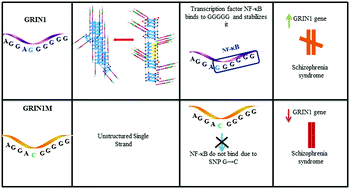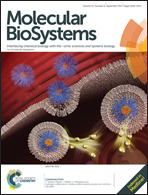Structural switch from a multistranded G-quadruplex to single strands as a consequence of point mutation in the promoter of the human GRIN1 gene
Abstract
A huge number of G-rich sequences forming quadruplexes are found in the human genome, especially in telomeric regions, UTRs, and the promoter regions of a number of genes. One such gene is GRIN1 encoding the NR1 subunit of the N-methyl-D-aspartate receptor (NMDA). Several lines of reports have implicated that attenuated function of NMDA results in schizophrenia, a genetic disorder characterized by hallucinations, delusions, and psychosis. Involvement of the GRIN1 gene in the pathogenesis of schizophrenia has been extensively analysed. Recent reports have demonstrated that polymorphism in the promoter region of GRIN1 at position −855 (G/C) has a possible association with schizophrenia. The binding site for the NF-κB transcription factor gets altered due to this mutation, resulting in reduced gene expression as well as NMDA activity. By combining gel electrophoresis (PAGE), circular dichroism (CD) and CD melting techniques, the G → C single nucleotide polymorphism (SNP) at the G-rich sequence (d-CTTAGCCCGAGGA![[G with combining low line]](https://www.rsc.org/images/entities/char_0047_0332.gif) GGGGGTCCCAAGT; GRIN1) was investigated. We report that the GRIN1 sequence can form an octameric/multistranded quadruplex structure with parallel conformation in the presence of K+ as well as Na+. CD and gel studies are in good correlation in order to detect molecularity and strand conformation. The parallel G-quadruplex species was hypothesized to be octameric in K+/Na+ salts. The mutated sequence (d-CTTAGCCCGAGGA
GGGGGTCCCAAGT; GRIN1) was investigated. We report that the GRIN1 sequence can form an octameric/multistranded quadruplex structure with parallel conformation in the presence of K+ as well as Na+. CD and gel studies are in good correlation in order to detect molecularity and strand conformation. The parallel G-quadruplex species was hypothesized to be octameric in K+/Na+ salts. The mutated sequence (d-CTTAGCCCGAGGA![[C with combining low line]](https://www.rsc.org/images/entities/char_0043_0332.gif) GGGGGTCCCAAGT; GRIN1M) remained single stranded under physiological conditions. CD melting studies support the formation of an interstranded G-quadruplex structure by the GRIN1 sequence. Two structural models are propounded for a multistranded parallel G-quadruplex conformation which might be responsible for regulating the gene expression normally underlying memory and learning.
GGGGGTCCCAAGT; GRIN1M) remained single stranded under physiological conditions. CD melting studies support the formation of an interstranded G-quadruplex structure by the GRIN1 sequence. Two structural models are propounded for a multistranded parallel G-quadruplex conformation which might be responsible for regulating the gene expression normally underlying memory and learning.


 Please wait while we load your content...
Please wait while we load your content...